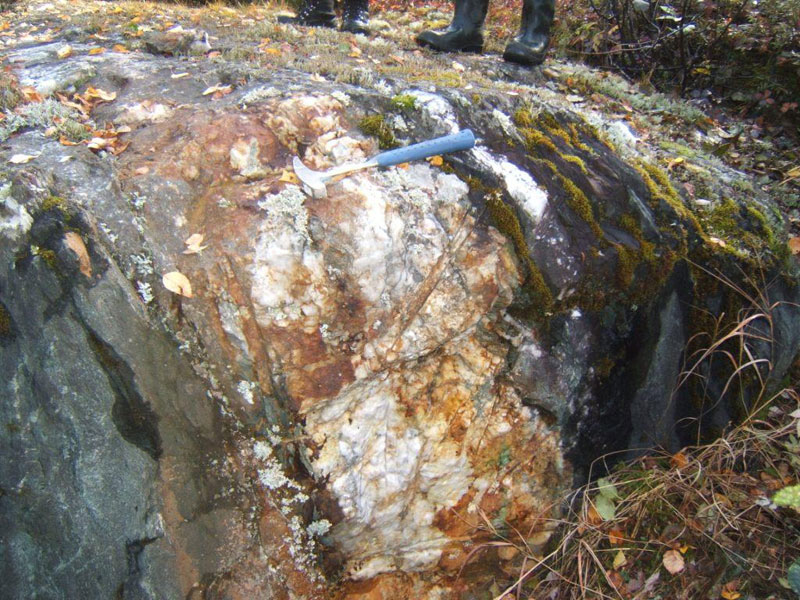All That Glitter Here is Gold: The Swedish Gold Rush

The rocks around 44-year old Bernth Engstrom glisten with gold. He has made this century’s discovery in Sweden and started a gold rush unprecedented in Wermland (Midwestern Sweden). Now people take off into the woods with picks and shovels. But Bernth takes the gold fever in his stride. The most important thing for him is that this discovery can create new jobs in this deserted area.
We find ourselves in the Klondike of Sweden – Wermlands Nyseter. Bernth Engstrom dislodges a rock with his pick; it glistens with gold dust. He weighs it in his hand and says calmly, “Here’s a souvenir for you!”
Bernth has made a dream come true, he has found gold! But it was a long and wearisome task. All the time he was working in a headwind; and for a long time neither the local authorities, a mining company, nor ordinary people believed him. They smiled knowingly, thinking that Bernth had caught gold fever.

“We really hit the bullseye!” Bernth comments, standing on the glittering rocks next to the E18 (a European motorway), and looking out over the wooded countryside. The area claimed is 600 x 2,000 meters, covering the main lode and a couple of branch veins with a high content of minerals. Everyone else came too late, and there was no point in the mining companies trying to carry on. Engstrom and Lindquist, together with the American company Tiger Mining, had already decided what they were going to do with the gold in Nyseter.
“First of all, it will be in the region’s interest to create new jobs in the deserted area of Wermland. As a guarantee of this, we will keep our influence in the company. At the moment, we are test boring and the mining might start in the summer,” explains the new “gold King,” Bernth Engstrom. He sits down on a rock with a pan, spade, hammer and a Goldspear next to him. In some ways, he is the picture of the traditional gold digger, who struggled through the American wildernesses, washed in the rivers and finally discovered wealth. Still the picture does not quite fit, because Bernth is deep down a realistic person whose great interest—geology—led him towards gold.
“There seems to be some magic in the word gold. Ever since people have understood that there really is gold here, I have not had a moment’s rest,” says he with a smile. “Suddenly everyone, local authorities and companies alike, is interested and I hardly have time to do my job as a welder in a smaller company. Sometimes I really wonder what I have got myself into,” he says.
WALKING ON A FORTUNE
There is something amazing and paradoxical about this story and Bernth smiles when he thinks about his own position.
“There I am walking on top of a fortune and at the same time, I have to survive as a normal worker. But believe me, it is not the wish to strike it rich which is driving me on, it is the strong desire to create something for my native area. And then, it is an exciting sensation to have succeeded with something so many others have not managed before.”
The story of Bernth’s success is quite exciting.
“Rocks have always been my great interest. This hobby gradually developed an interest in geology. I studied all available literature on the history of how all the different kinds of rocks had evolved, and the kind of rocks which are often hiding various minerals. And, I promise you that the dramatic events many millions of years ago which created the earth are very interesting.”
Bernth gradually worked down to the basic bedrock in the southwest of Wermland, which mainly consists of acid silicates of volcanic origin—bedrock that had possibilities of containing gold, silver, copper and other valuable minerals.
“Many years ago, I got hold of a gold pan, dressed myself up for fun as an original gold digger and started panning in the western rivers of Wermland. I soon discovered some small fragments of gold in many places, just like the estuaries I had read about in the gold rush in America in the late 1800’s. But this river gold is not extensive enough to be profitably worked.
“However, ” confessed the naturally imperturbable Bernth, “my pulse was definitely racing the first time I saw the glitter of gold in the bottom of the pan. I did not fully believe it was true, but an analysis showed it was pure gold—it was fantastic…!”
PICKING UP ROCKS
These small quantities of gold whetted his appetite. Because if there were gold fragments in the river, there obviously had to be some richer lodes nearby. This encouraged him to pick rock samples form the hills in every moment of his spare time. He learned how to look at the vegetation and other signs of nature where there were minerals. He studied the geological map of the area and came to the conclusion that near Wermlands Nyseter was the best site to find minerals. He bought an instrument called Goldspear, which indicates precious metals. now he became pure gold prospector!
Because his wife, Margareta, is just as rock crazy as Bernth, the mineral hunt became their most overriding hobby for many years. And in 1987, the family won the mineral hunt in Wermland with a rock containing 67 grams of gold per ton—the highest content ever recorded in Sweden!
“Together, we discovered an ancient moss-covered mine shaft. After we scraped off the moss, we saw the rock face was gleaming. It was there that we found these gold nuggets.”
When Bernth came to Wermlands Nyseter four years ago, he heard a remarkable story which made him even more inquisitive than before. It was about Anton Tobiasson from the small holding of Tronhatten, who had traveled to the United States in the last century. He worked in the Michigan and Minnesota mines and returned three times to his homeland—in 1910, 1917 and 1937. On all three occasions, he tried to start up a mining operation in a mile-long mountain ridge. He got the nickname Mr. Stone.
DISCOVERY OF A MINE SHAFT
When the E18 was constructed some tens of years ago, they had to go through a hill which contained some strange yellow streaks in some places. The hill blasted and cut away and no one investigated what the yellow in the rocks could be. The site was christened “The Yellow Bypass.” But now some elderly inhabitants began to remember Mr. Stone’s unsuccessful mining operation a generation ago. Bit it was obviously not possible for the yellow streaks in the rock to be gold…
Bernth listened to all these old stories and started to apply for a mineral claim in the hottest area. His visits to the area with a pan and a Goldspear became more frequent. Bernth and Maragareta located first the old mine shaft and were then able to trace in which direction the gold lode was running. With the help of a compass, they continued to follow the lode heading and finally came out on the Yellow Bypass at E18, and after that they ended up in the mine of Mr. Stone about a mile further on.
“I became gradually more convinced that we had found a very rich vein and not it was important to claim the whole valuable area,” smiled Bernth.
It was now the partner Hans Lundquist, geologist and lawyer, who came into the picture. They made a mineral claim, and they have since been offered considerable amounts for this claim, but are not selling for any amount of money.
DIFFICULTY WITH WORK
“Well, this is a strange situation at the moment,” Bernth says. “All this fuss and bother has made it difficult for me to continue my normal work in Arvika for many months now.”
In Arvika, Bernth lives together with his wife Margareta, who is a teacher, and their two daughters, Paulina, four years, and Lovisa, seven months.
“These three are really the most important lumps of gold in my life,” says Bernth with his quiet smile.
Right now, Bernth and his partner are faced with an important decision about how it is going to be in the future. One thing they are both certain about—never let go control of the management of the proposed mining operation, which will probably take off next year.
There is no gold fever in the eyes, nor in the way of talking when he describes the fortune which is still untouched under his feet. The excitement for him was during his prospecting, and now when the launch is approaching, his enthusiasm is that it will be such a benefit for all the unemployed in his deserted home village.
HOW WILL THE PROFIT BE DIVIDED?
The government has a right to 50%, the landowner 10% and the developers the remaining 40%, which has to cover the mining operation. So the possibility of becoming a billionaire will probably not exist.
Although the owners of the claim and the landowners do not have gold fever, many others do. Cars often stop at the side of the road. Many people with all kinds of tools have started to pick out all the yellow rocks at the roadside. During our interview with Bernth, two different “gold robberies” occurred just in front of us.
“It doesn’t harm my economy, but it is a little strange that people come to an area already claimed and carry away a lot of gold and mineral rocks. By law, this can be punished by up to six months in jail, but I have not reported anyone. Because it makes very little difference, compared with all the rocks blasted and moved away during the road construction.”
By law in Sweden, the commission for the state can be up to 50%. However, if a new development and exploration becomes beneficial for local work opportunities, this will reduce the government’s commission to a small percentage only of the mining company’s net profit.
Editor’s Note: Shortly after this article was written, the operation became a public company. The first issue of 25 million kronor (4 million US dollars) was over-subscribed within two days on the public stock market in Stockholm. The mining company name is Wermland Guldbrytning AB, if anyone likes to check prices today.

